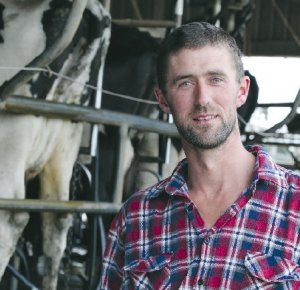Apart from choosing reliable bulls, he has sought to improve the quality of his growing herd with better reproductive technology and reproductive management.
Leigh and Kelly Schuuring sharefarm on 293ha at Mella, “five minutes out of Smithton” on Tasmania’s north-west coast.
They own the herd of 900 Holstein-cross milking cows; their aim is to level out at about 1000 high production cows.
Last year, working with local veterinarian Craig Dwyer, they introduced Bayer’s reproductive fertility regulators to synchronise all the cows in the herd, making them ready for AI on the same day.
Fixed Time AI removes the need for heat detection and, using Bayer’s fertility regulators, they got more cows in-calf earlier, enabling them to deliver more calves in a tighter calving pattern.
“One advantage of this programme is that we get three shots at AI in the six-week mating period, rather than just two in the previous programme Leigh used,” Dwyer says.
While the basic mechanics of an Ovsynch programme are much the same in all dairy herds, Dwyer reminds that each herd is different.
Dwyer sets up the structure of the Schuuring’s breeding programme a month or so in advance. This involves ensuring the heifers have reached a target mating weight (which will vary somewhat for individual animals); feed transition management into early lactation; and checks for endometritis and other potential reproductive problems. He advises on the programme and administers the Bayer reproductive regulators, while the farm’s four workers do the bulk of the day-to-day reproductive management tasks.
In their first year on Ovsynch, the Schuurings achieved an 81%, six-week in-calf rate (ICR), well up on the 73% ICR with their previous AI programme. This year their six-week ICR has improved again – to 84%.
“This year’s better in-calf rate is a result of last year’s work,” Dwyer says. “Once we had achieved a tighter calving pattern through the Ovsynch program, it gave more of the cows a longer break after calving.
“They came into mating in just that bit better condition,” Leigh added.
The improved ICR contrasts with the fertility trend in dairy cattle that has seen the ICR in the nation’s dairy herds falling by about 1% a year for the past decade, according to Dairy Australia.
Heifer weight is a critical factor in achieving successful pregnancies. Dairy Australia says many heifers are underweight at first mating; they are not reaching their full potential for milk production nor do they get in calf as successfully.
Smaller heifers tend to also calve later and don’t repay their rearing costs until they are in their second lactation.
“The Ovsynch program has allowed us to get a high percentage of the herd calving early,” Dwyer says. “This gives them extra time to grow; they are heavier at their first mating. So we’ve seen a positive effect on the pregnancy rate the second time we’ve used the Ovsynch programme.”
At an estimated growth rate of 0.7kg/day, an extra week gives a better chance of reaching the ideal weight of 350-370kg for first mating Holstein heifers. They are also more robust and survive better in the herd.
By achieving a higher percentage of cows in calf, the Schuurings are in a stronger position when making culling decisions; they can cull quite hard in order to keep the best quality and most productive animals and still meet their heifer replacement target.
“It’s a benefit to be able to keep these heifers as they come into the herd and increase milk production,” Schuuring says.
With the earlier calving, peak milk production is also reached earlier. The programmes enable them to pre-plan calving in spring to match the peak pasture curve.
“We’re calving when the best pasture feed is around, which means we’re getting the milk in the vat and also saving on extra feed costs,” Schuuring says. “This year milk production is 11% ahead of the previous year at the same time.”
Schuuring estimates they have seen $30,000 extra milk production alone from the programme. “There could be more. It’s definitely paid for itself in the first calving.”
An additional benefit of a calving pattern in which most calves are born in the first three weeks is that it provides an intense management focus.
Of the 850 cows calved last spring, 80% were born in the first three weeks. “When you have a longer, drawn out calving period, you get tired, you lose focus and you lose calves,” Schuuring said. “With a tight calving pattern we’re focused and we lose few.”
Schuurings were this year runners up in the ANZ Tasmanian Dairy Farmer of the Year Awards and won the Pasture Management Award.
















